18 Blueberry Companion Plants | What Grows Well with Blueberries
Can you imagine having a pick-your-own orchard in your very own backyard? That’s one of our family’s most treasured focuses in the garden! We decided to find the best blueberry companion plants to make the most of our garden space for fruit that will come back year after year!
Companion planting blueberries allows us to maximize the space we have while helping all of the plants thrive.
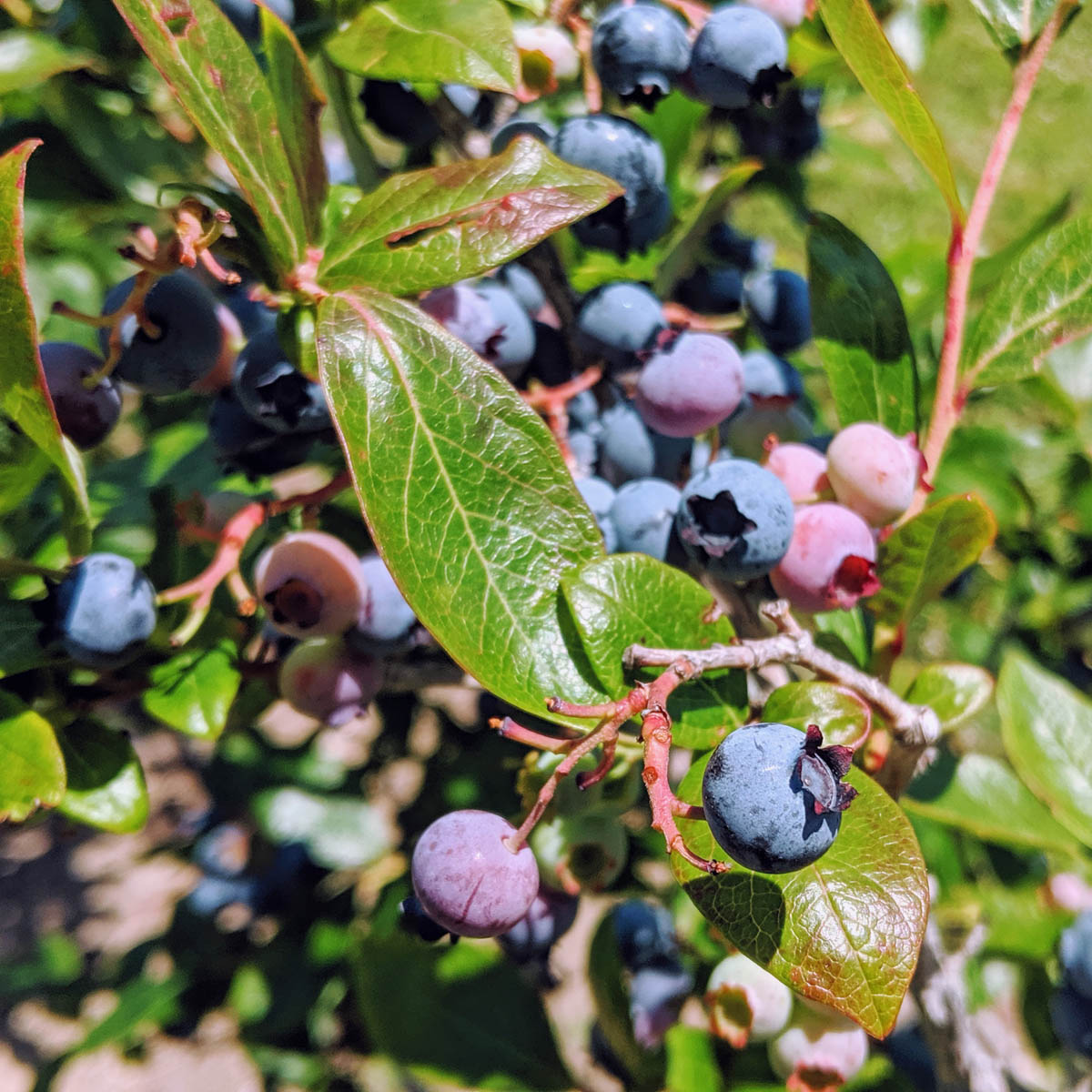
I am deeply in favor of adding blueberries to your garden or creating an edible landscape. You and your family can enjoy the fruit harvests along with the attractive foliage.
Let’s work on finding some great choices for companion planting blueberries in your backyard garden!
Where to Plant Blueberry Bushes
Understanding what blueberries need in terms of soil and care can help in choosing blueberry bush companion plants.
First, don’t make the same mistake I did! Blueberries prefer full sun. I planted my original blueberry plants in the back of my yard along the fence, which also happens to be directly below a tree line that shades them for much of the day. Boo!
Also, it’s important to note that blueberries truly prefer acidic soil, particularly as low as pH 4.5.
For this reason, you’ll want to make sure any blueberry companion plants also thrive in acidic soil.
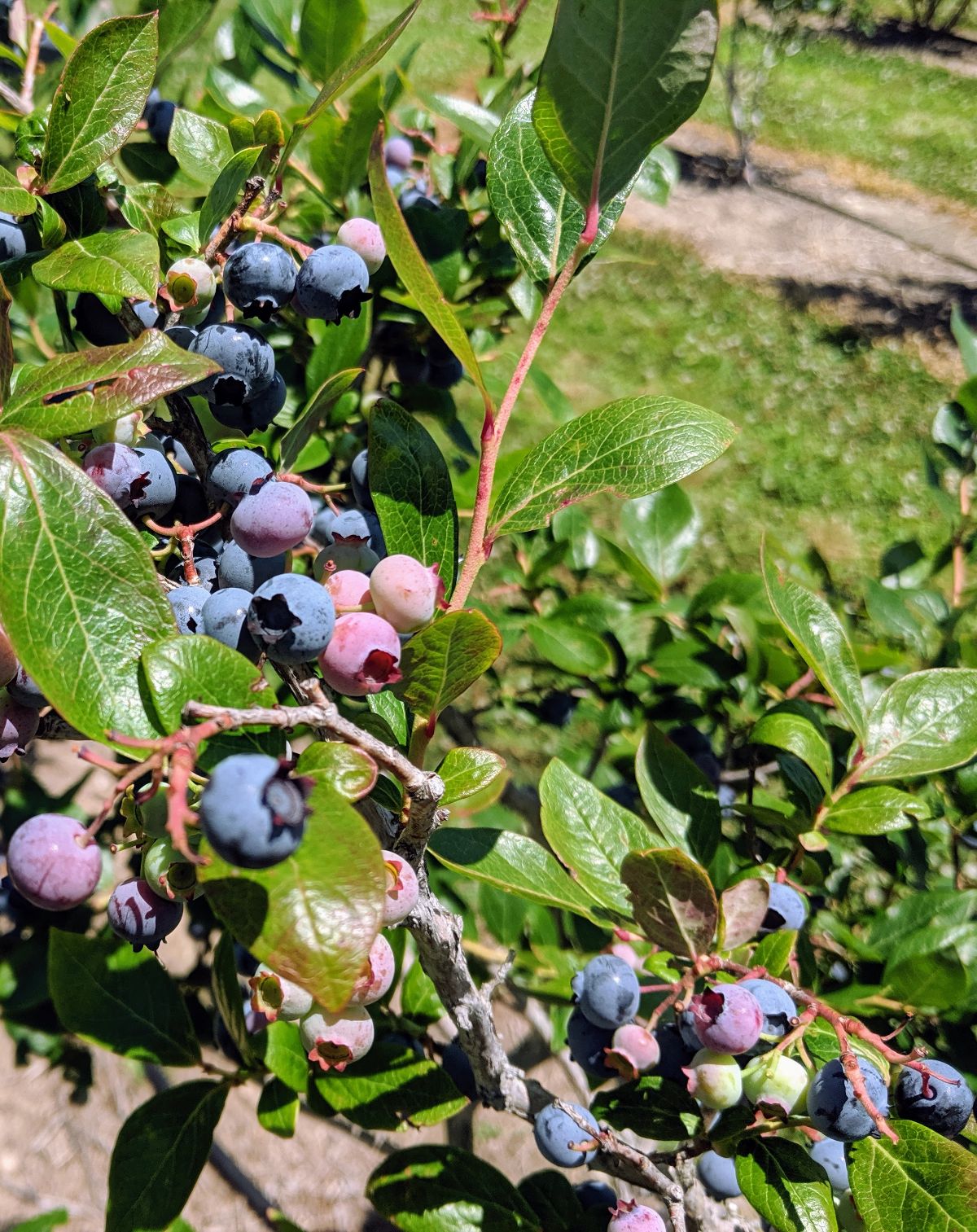
Best Companion Plants for Blueberries
Finding the best companion plants for blueberries starts with looking at the needs of blueberry shrubs and what other plants also thrive in those conditions.
Here’s what we know about blueberry bushes:
- Choose a sunny location – blueberries love full sun!
- Check the soil pH. Blueberry bushes thrive in acidic soil.
- Space them out at least 3 feet apart when planting.
- Water at least 1” per week and up to 4” once they are producing fruit.
An ideal companion plant for blueberries would also thrive in these conditions. Of course, you might have a little wiggle room with the soil.
You can amend the acidity with an acidifier product that allows you to target specific plants rather than the entire garden.
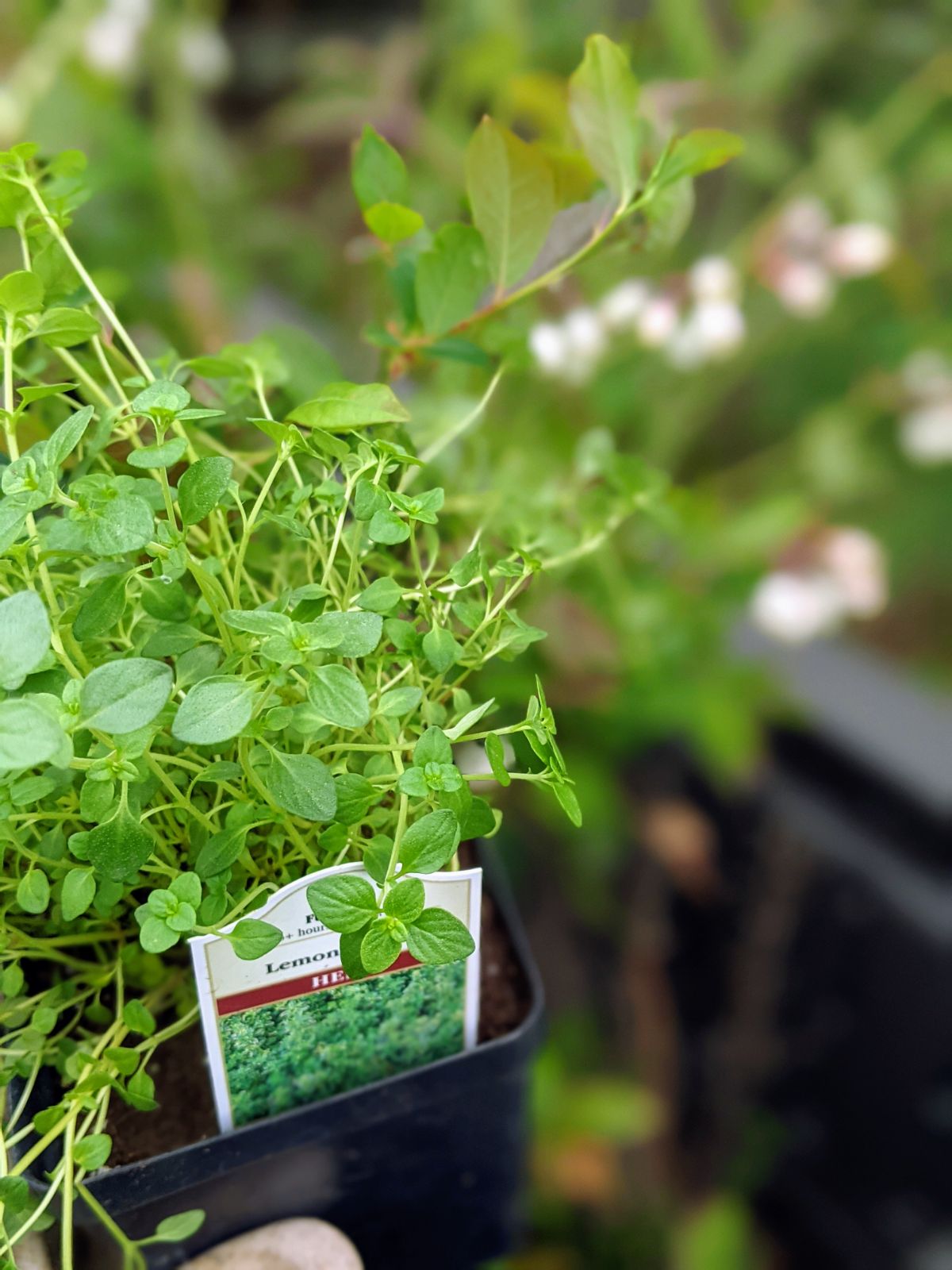
Herb Companion Plants for Blueberries
Consider growing herbs alongside your blueberries for benefits on all sides.
Basil
Basil works well as a blueberry companion plant. This beloved herb grows fine in somewhat acidic soil and adds its own mix of benefits to the blueberry garden. Namely, basil helps with natural pest control.
Growing to about two feet tall, basil can grow peacefully near the blueberry bushes without casting too much shade.
Thyme
As a perennial herb, thyme grows low to the ground and serves as a fine ground cover for blueberry bushes. With this plant pairing, thyme acts as live mulch, keeping weeds at bay and helping to regulate moisture.
Blueberries and thyme can both offer natural pest repellent properties, making this duo a great choice from the start.
Thyme and blueberries are also both perennials, so you won’t have to plan what to plant every year – set it and forget it!
Thyme is one of my top choices for my own blueberry garden plan.
Parsley
Another popular herb to companion plant, parsley tolerates acidic soil very well. This common herb acts as a host plant for Black Swallowtail Butterflies and can help to repel unwanted garden pests.
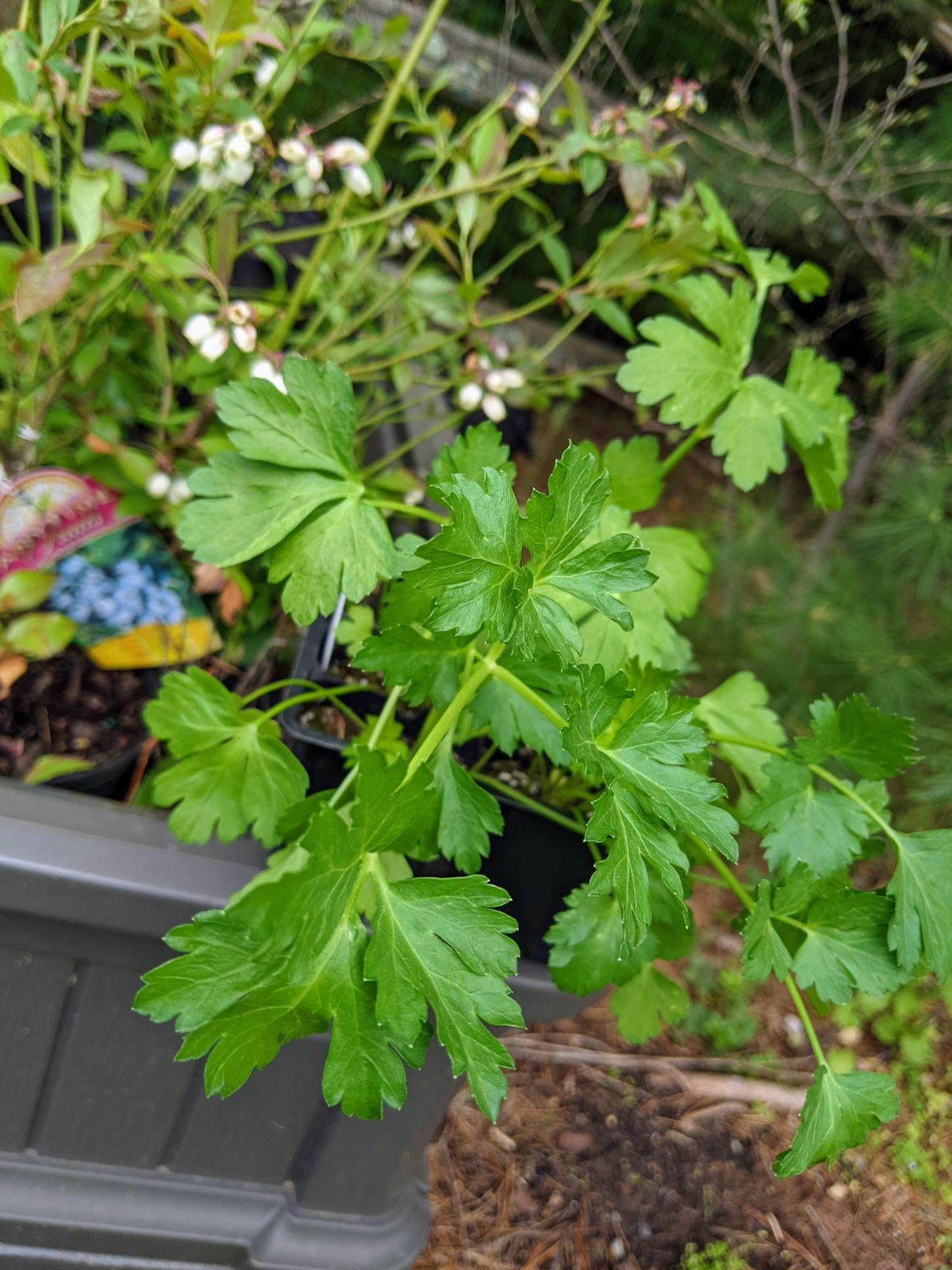
Dill
Similar to parsley, dill serves as a host plant for black swallowtails. Dill enjoys soil pH between 5.0 and 6.5. This helpful garden companion attracts beneficial insects such as ladybugs and predator insects such as wasps and mantises.
Borage
Popular for its edible flowers that you may like to freeze in ice cubes, borage looks beautiful nearby blueberry bushes. Try borage as a blueberry companion plant; it does well in a wide range of soil types, from pH 4.5 to 8.5.
If left to its own devices, borage can be a bit invasive, so be sure to cut it back and maintain whatever you plant.
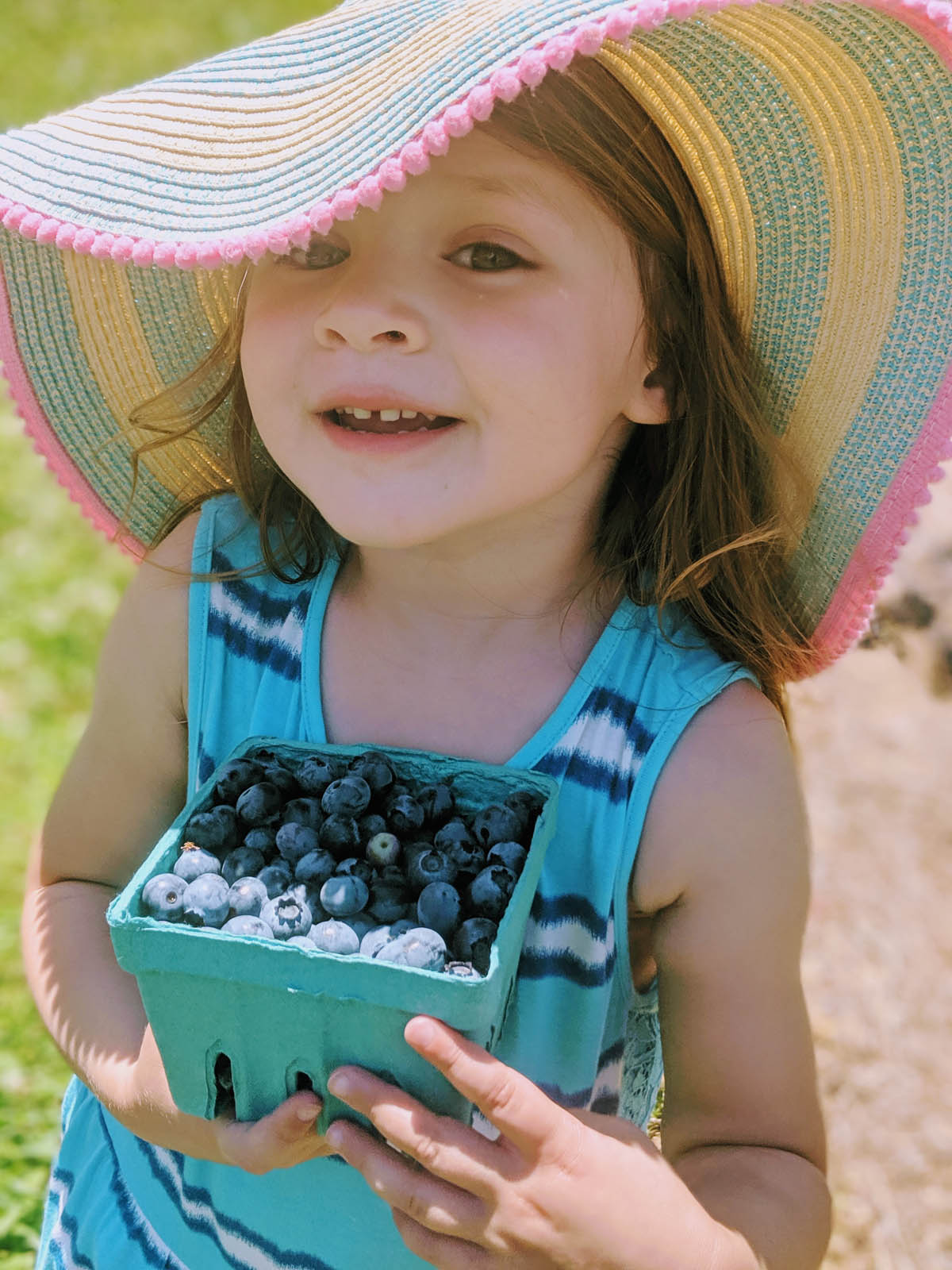
Fruit Blueberry Bush Companion Plants
Growing lots of fruit in the backyard is such an enticing plan! Consider these fruit blueberry companion plants.
Strawberries
Try growing strawberries as companion plants for blueberries. Make sure to leave a good amount of space around the roots so your plants don’t compete.
Some reasons why planting blueberries with strawberries is a good idea:
- Acidic Soil Conditions – Both blueberries and strawberries grow well in acidic soil. Together, the plants would do well in a 5.4 to 5.5 pH range.
- Pollinator Friendly – Strawberries and blueberries both rely on pollinators for fruit set. When you want to increase your fruit harvest, the more pollinators the better!
- Use of Garden Space – While blueberries grow vertically, strawberries spread out horizontally. Congrats – you’re making the most of your garden space!
- Aesthetics – The leafy foliage of the blueberry plants looks attractive with the delicate white flowers of the strawberry plants below.
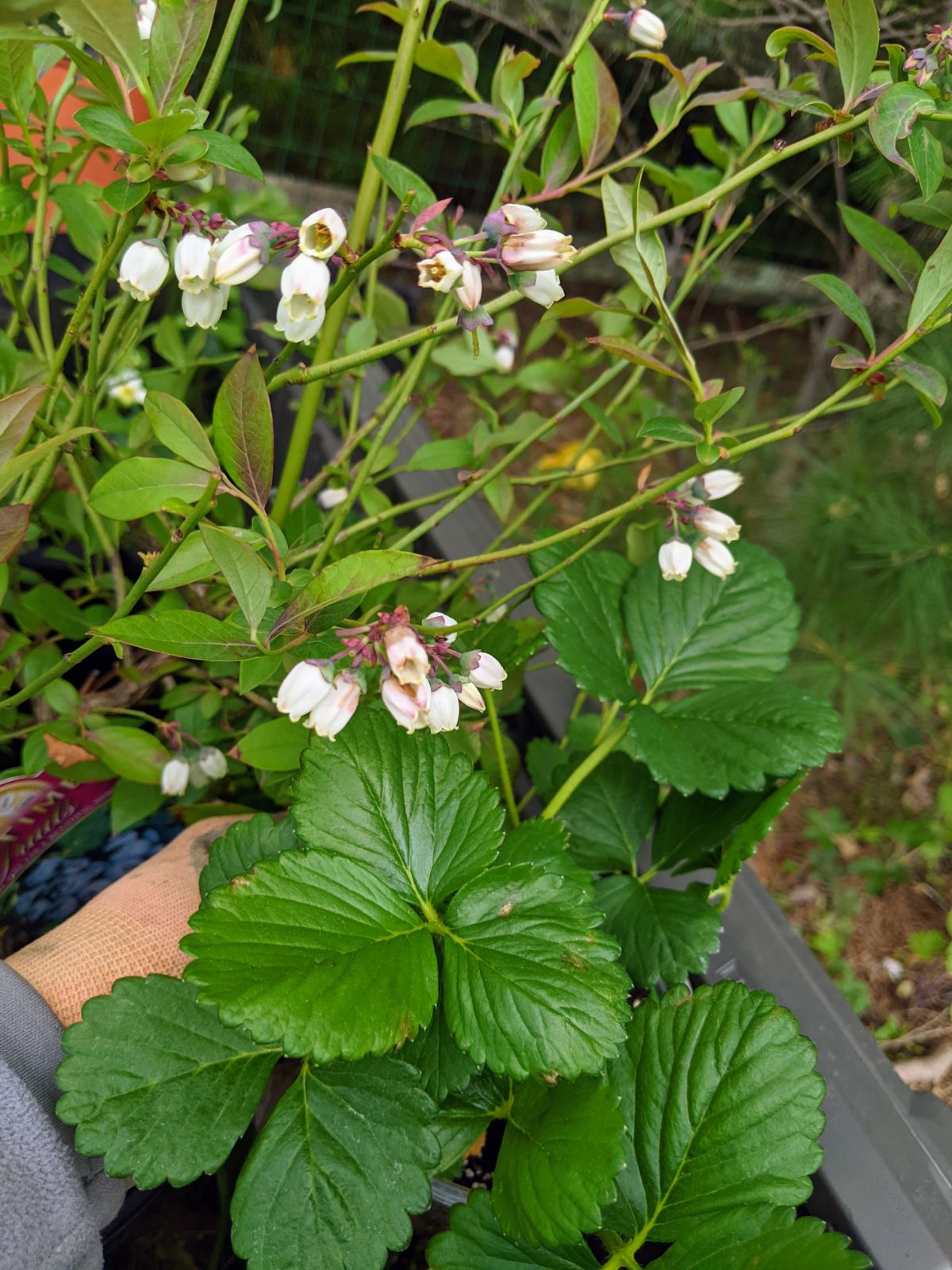
Pineberries
As they have a very similar growth habit, you may also consider growing pineberries nearby to your blueberry bushes.
Pineberries would make a great plant to grow near blueberries for the same reasons as their cousin, strawberries.
Cranberries
While they may seem exotic to grow in the home garden, you can find cranberry bushes for sale to complement your backyard fruit orchard.
Cranberries require acidic soil just like blueberries, making them fine to grow together. According to the University of Maine Cooperative Extension, cranberries prefer soil with pH of 4.0 to 5.0, which is just like blueberries.
With this in mind, you can prepare the garden bed once for both plants! Use a soil acidifier if needed to reach this range.
Companion Flowers for Blueberries
Flowers with similar growing needs should work well as companion flowers for blueberries. Keep in mind where the shadows will fall so as not to shade your blueberries with larger shrubs and trees.
In a sprawling landscape or border, consider these flower pairings for blueberries.
- Coneflowers – A fantastic pollinator magnet and native perennial that should return year after year, echinacea coneflowers can be a great match for blueberries in the garden.
- Daisies – Available in numerous perennial varieties, daisies can grow nicely near blueberries, attracting pollinators and adding a touch of delicate beauty to the setting.
- Rhododendron – A rhododendron also prefers acidic soil and a sunny spot in the yard.
- Azalea – Also happy in acidic soil, azaleas are another flower to consider planting near blueberries.
- Lilacs – If you have lots of space to fill and the soil is largely acidic, consider growing lilacs as blueberry planting partners.
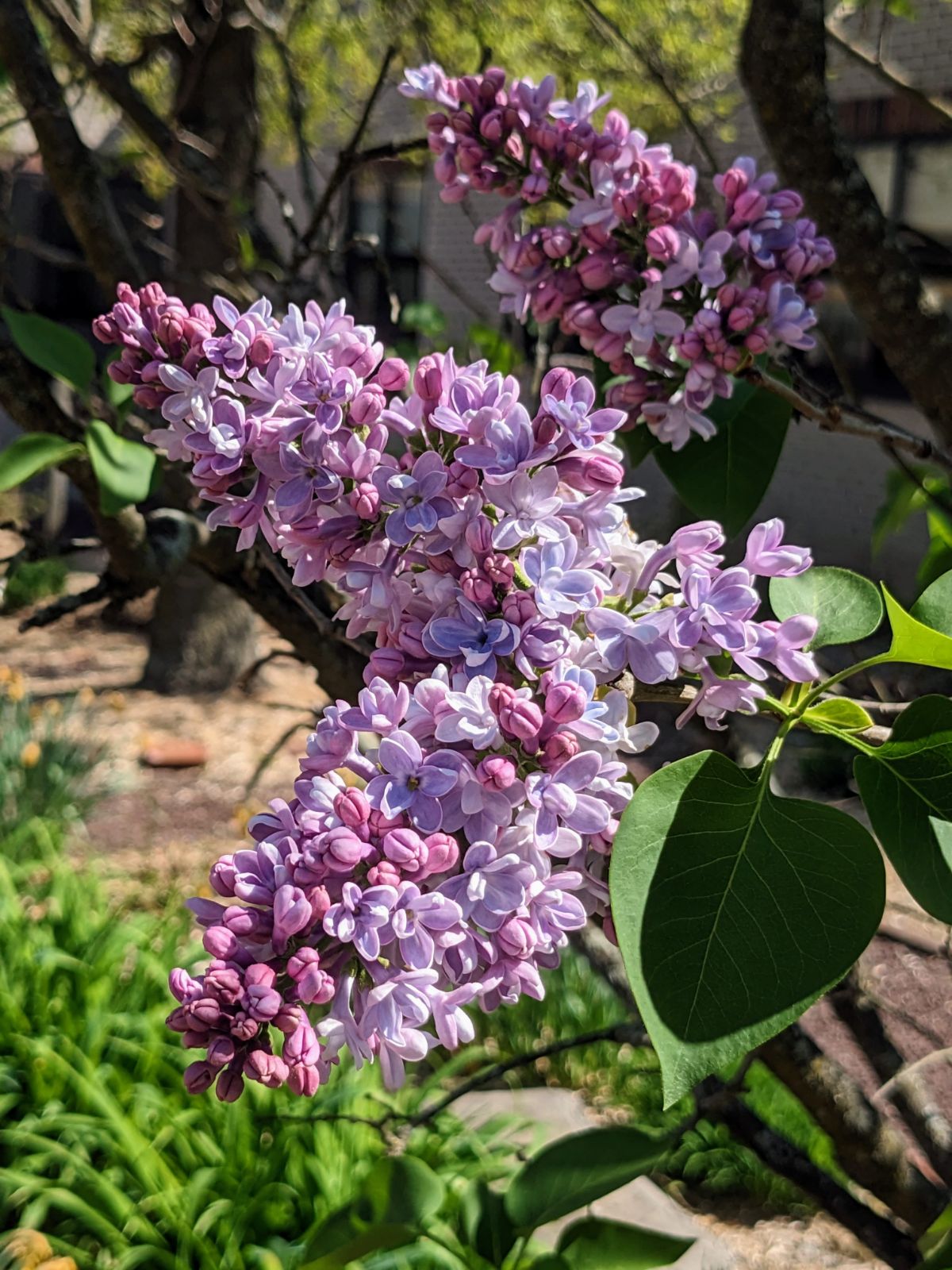
Trees and Shrubs that Grow Well with Blueberries
In general, evergreens usually grow well with blueberries. Most of the time they both enjoy the same conditions, right down to the acidic soil. Some flowering trees listed above, like lilacs, also work well when companion planting berries.
Here are some trees and shrubs to consider if you are using blueberry bushes in landscaping for your property.
- Arborvitae
- Blue Spruce
- Dogwood Trees
- Junipers
- Pine Trees
In fact, I often place pine needles under my blueberry plants as mulch. The University of New Hampshire Extension and Oregon State University Extension Service both bust the myth that pine needles help acidify the soil.
Still, the needles work as a functional mulch, helping to keep weeds at bay while also retaining more moisture for the plants.
Companion Plants for Blueberries in Containers
When growing blueberries in containers, you may wish to avoid crowding the plants too much with companions. Consider topping the pots with a few inches of mulch to help retain moisture and aid in weed control.
However, if the pot is large enough and the blueberry bush is happy, you may consider these companion plants for blueberries in containers:
- Thyme
- Parsley
- Basil
- Strawberries or Pineberries
If you notice either of your companion plants aren’t doing well, consider transplanting the herbs or strawberry or pineberry plants to another location.
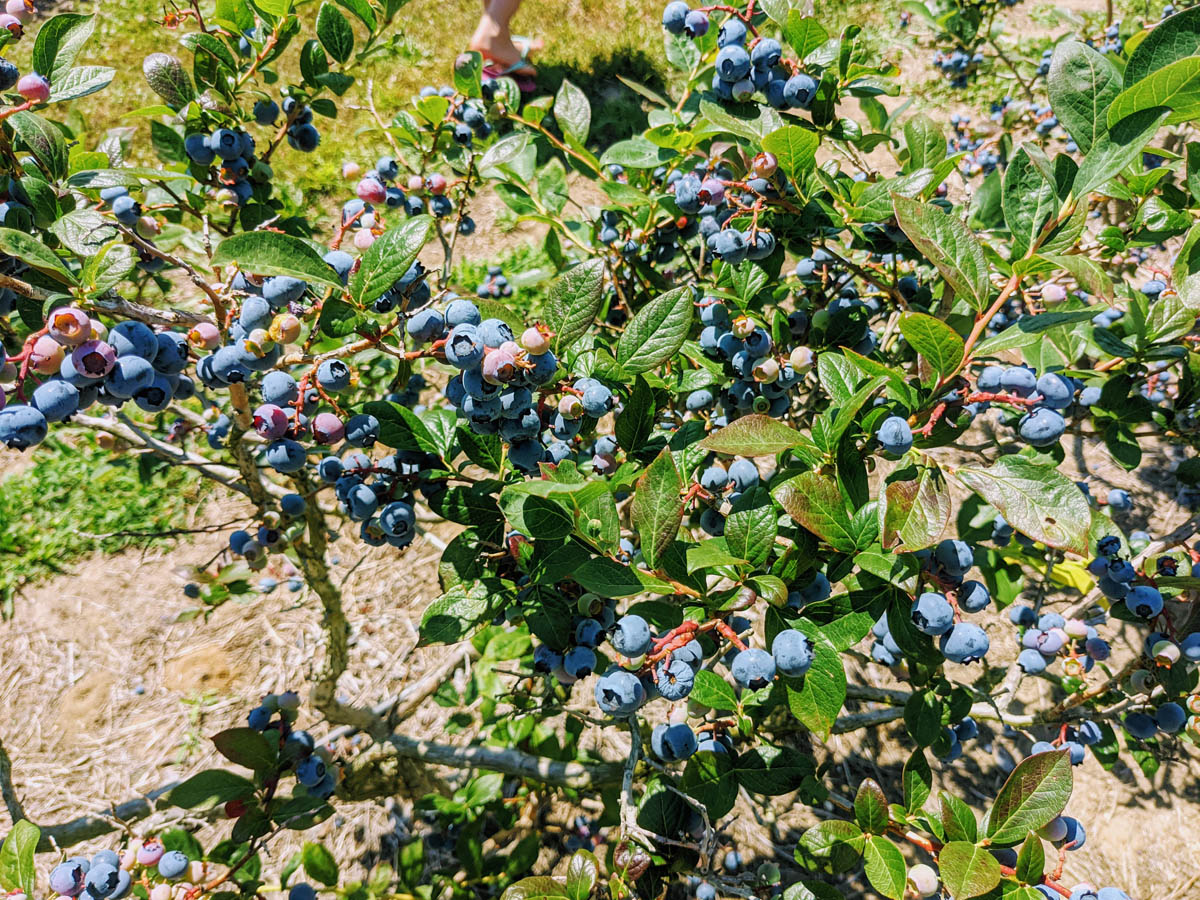
What are some bad companion plants for blueberries?
Are you wondering what not to grow near blueberries? Plants requiring alkaline soil or heavy nutrients would not be good companion plants for blueberries. Furthermore, you should take care not to allow any plant companions to shade your blueberry plants.
Blueberries need full sun to thrive and would not do well with too much shade.
Here’s what not to plant with blueberries:
- Nightshades – Tomatoes, Peppers, Eggplants, Potatoes
- Brassicas – Brussels Sprouts, Kale, Broccoli, Cabbage, Cauliflower
- Melons – Cantaloupes, Honeydews, Watermelons
- Greens – Lettuce, Collard Greens,
- Some Herbs – Oregano, Sage, Tarragon, Marjoram, Mint
- Beans
- Beets
- Peas
- And numerous others!
According to Redemption Permaculture, quite a few plants would be considered poor plant buddies for blueberries. If you have a specific pairing you were hoping to try, check out their full list to help ensure you have the best planting companion.
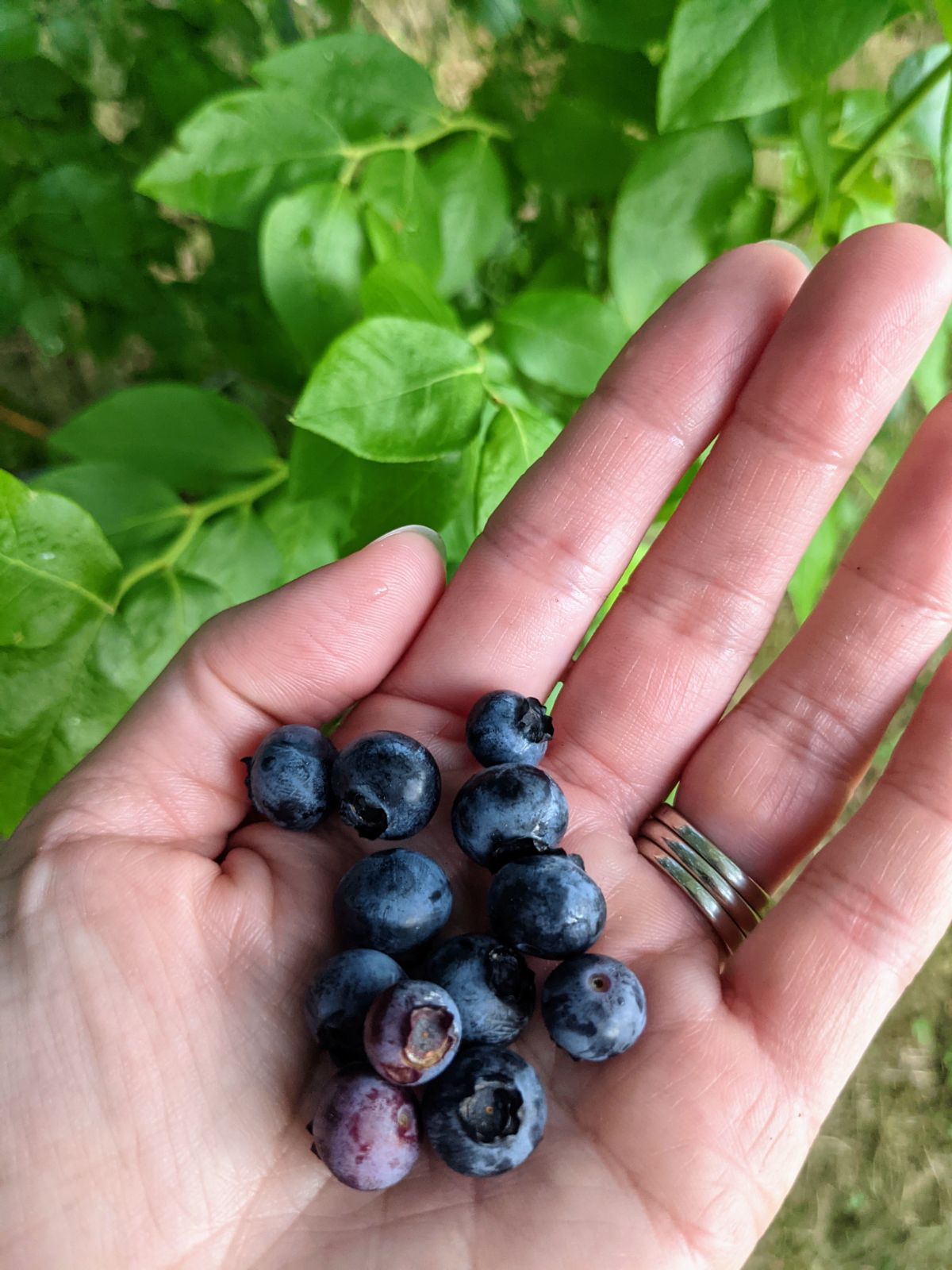
My Plan of What to Plant with Blueberries
Right now, I have one Blue Crop blueberry bush planted along the fence next to my original raised beds. Another blueberry plant is growing in a raised bed with strawberries.
I have the other Jersey blueberries along the back fence. They get too much shade there but it would be a lot of work, time and effort to move them. I’ve decided to let them stay and just buy MORE blueberries! 🙂
Once I make some time, here is my plan for what to plant with blueberries in our yard.
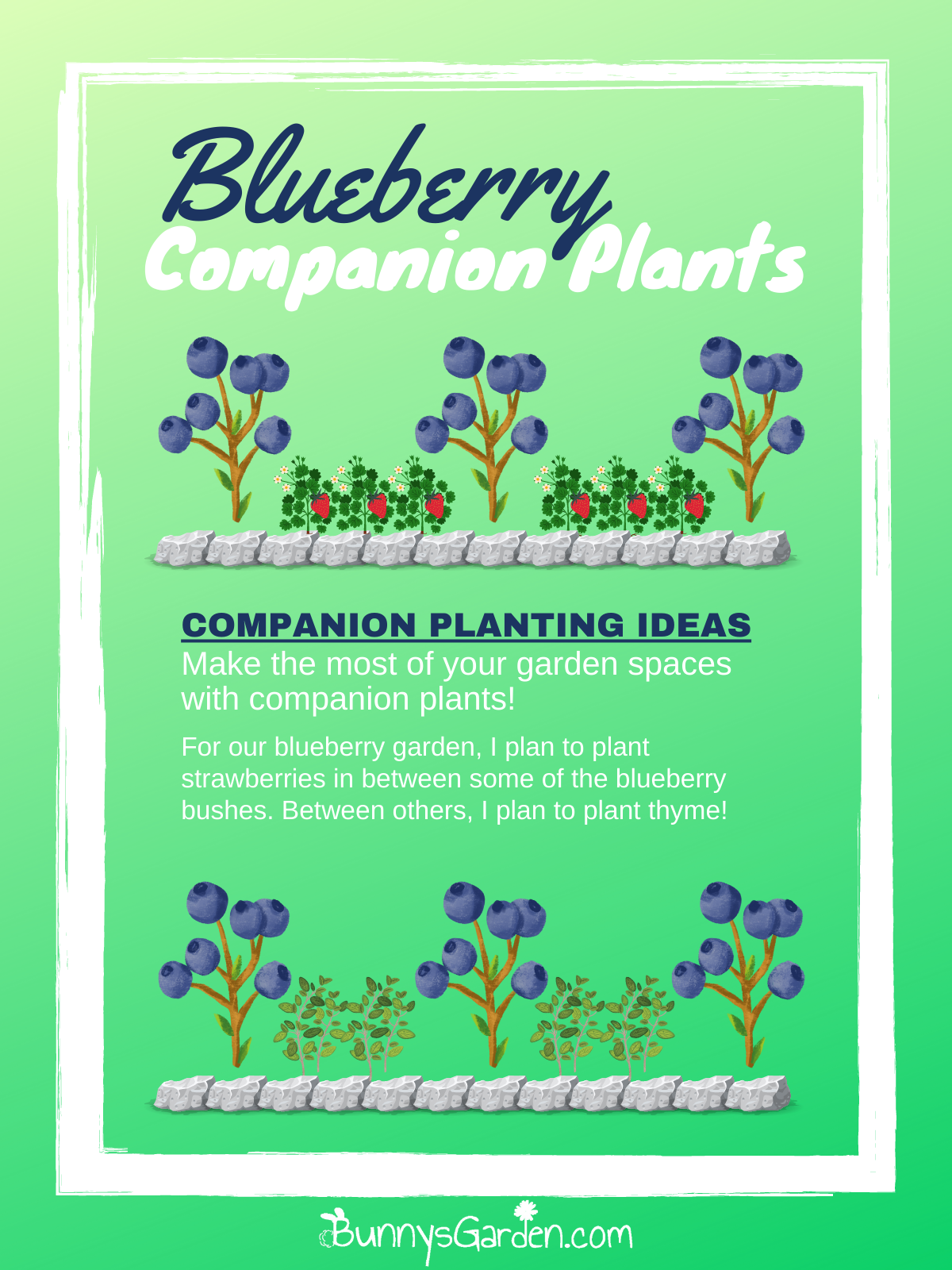
I definitely need to get the stone edging to protect everything from the weed whacker!
FAQ
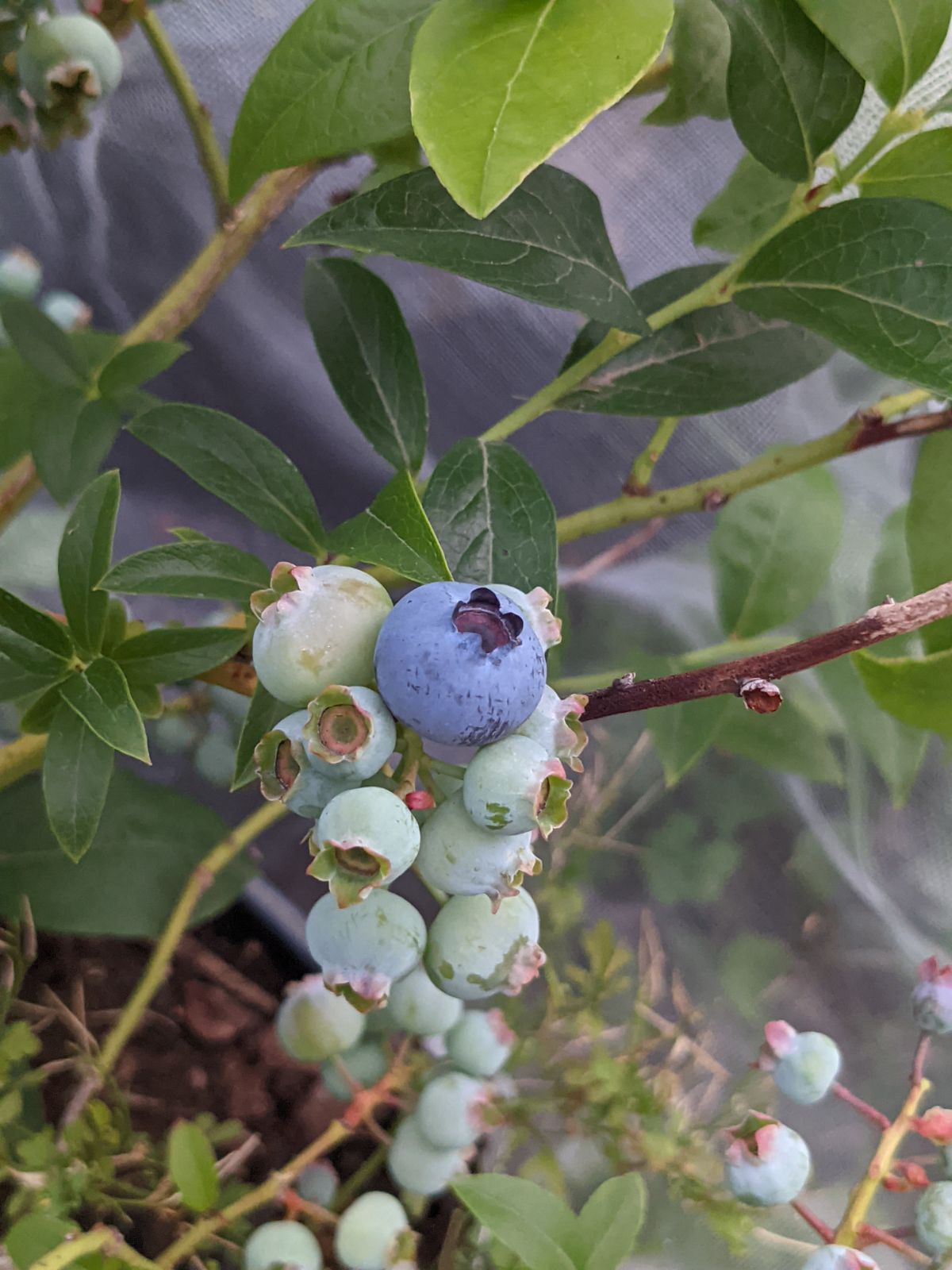
Companion Planting Blueberries
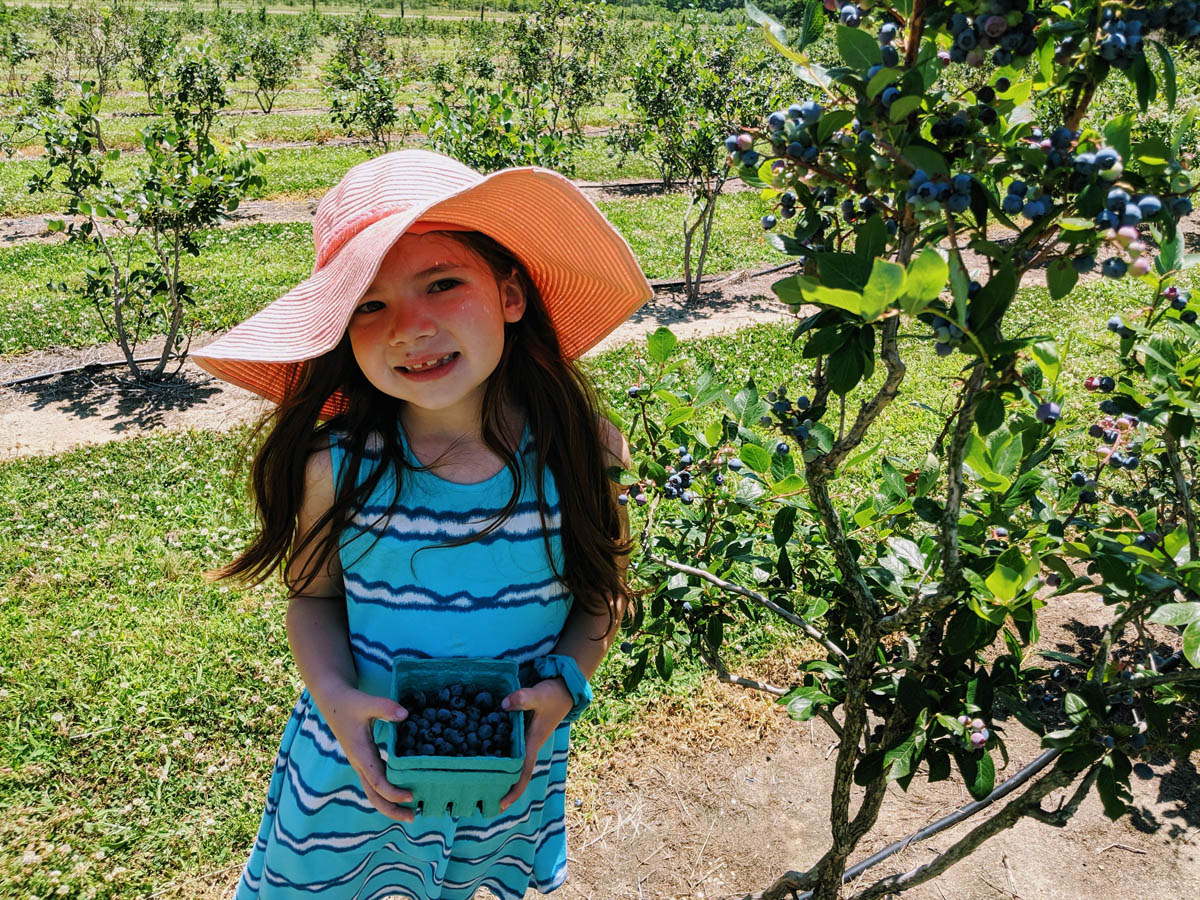
Final Thoughts on Blueberry Companion Plants
When searching for good blueberry companion plants, permaculture urges a sustainable, self-sufficient, and beneficial focus for your plantings. Keep this in mind as you work to build out your own backyard orchard, or whatever your dream happens to be. (That’s mine, anyway!)
Think about the cause and effect of different plant pairings and how you’ll need to maintain whatever blueberry companions you choose.
Transplanting blueberries is relatively easy if you decide to expand your berry patch for more space!
Choosing good companion plants for blueberries is only as valuable as being able to tolerate any future work you’ve created for yourself.
In other words, NEVER plant mint near your blueberries!!! Haha!
I’ve offered my best insights from lots of research on this topic – I hope this post helps you with your garden planning.
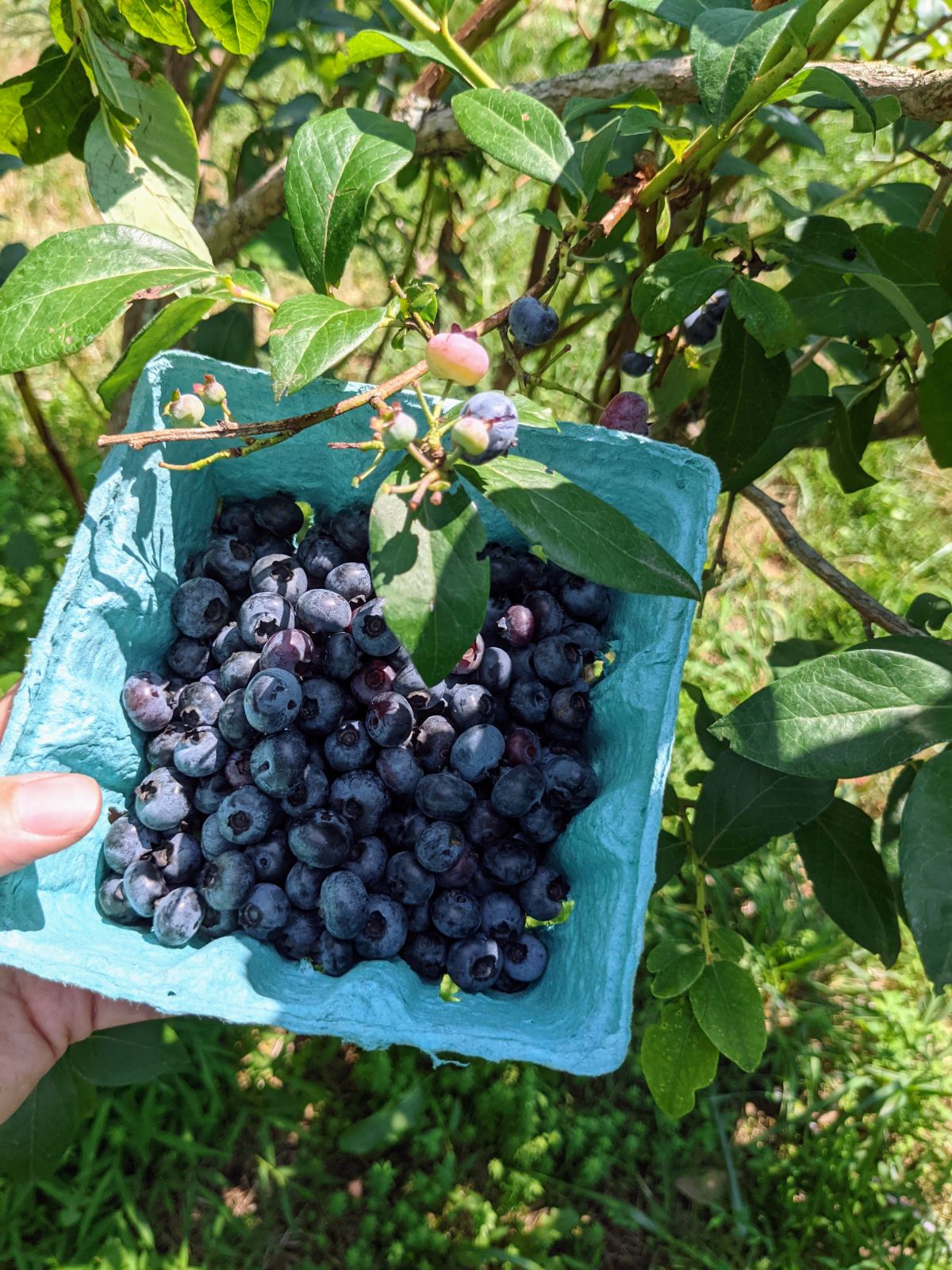
Here are few well-rated plants I’m leaving here for safe keeping. Blue Crop is absolutely delicious!
Our website features affiliate links to products that we personally believe in. If you make a purchase from a link on our site, we may earn a small commission at no cost to you. Thank you! This helps our girls chase their garden dreams! Thanks for your support. (View full affiliate disclaimer at the end of the page.)
If you have other suggestions for some great companions for blueberries, please shout them out in the comments below. Feel free to ask questions or share any good blueberry stories as well – we love hearing your personal anecdotes!
Happy Gardening!
Editor Notes:
Edited to fix a typo and add a few blueberry and plant companion recommendations.
05.15.23 – Updated to freshen the post and added new photos and a graphic of my own blueberry garden plan. Fixed spacing and bold on subheadings. Added link to blue crop post and cooperative extension, also added FAQ section. Resized photos to be full size. Shortened SEO title. Updated the date from 9.29.21 to reflect substantial edits.
05.31.23 – Updated to add links to netting and transplanting.
06.12.23 – Added section on companion planting with blueberries using examples of pairings and moved some questions down. Moved down the bad companions as well as adding more companions.

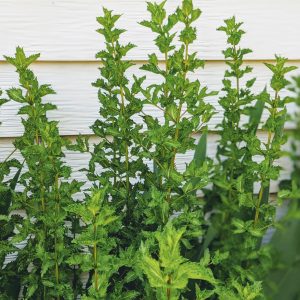

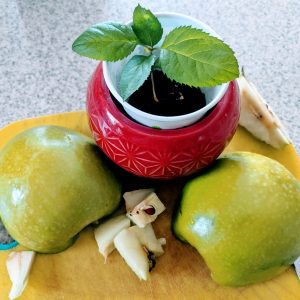
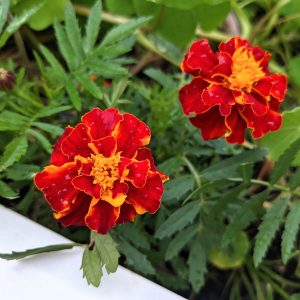


I have one blueberry plant in a container, I do not recall what type it is. I live in south-central Idaho. Do I need another blueberry for pollination? The plant I purchased already had berries on it. I feed with Miracid every 7 days and water every other day.
Hi Teresa, great to hear from you! I would definitely treat yourself to another blueberry plant or two. 🙂 The pollination is said to improve greatly with more plants, especially if you look up your blueberry type and find a preferred pollinator. I also want to recommend acidic soil and full sun for your blueberry plants. (One more thing – keep them safely covered or protected in winter as a hungry animal chowed down on ours, right down to the ground so no berries for us this year.) Best wishes with your blueberries!
Hello! I don’t really understand your comment on mint. could you please explain a bit more? I want to plant my blueberries in a location that is currently covered in mint.
Hi Kendall, nice to hear from you! Apologies for the confusion and sorry for the delay. I am happy to explain as best I can. Mint tends to be invasive so I generally do not recommend it as a companion plant. I’ve planted a few small sprigs of mint and it takes over an entire 30ft or so flower bed EVERY year. I rip out the entire thing every year and it completely grows back by the next year. I just wouldn’t want an important crop like blueberries or other fruit bushes to struggle to stay established when mint could literally choke the roots. All this being said, it’s not impossible because I do have a butterfly bush growing in the same bed as the mint – but the roots do become entangled and I feel it is not as healthy as it would be without mint in the same place. I hope this helps! Feel free to ask anything else – best of luck with your blueberries!
Rhubarb seems happy near blueberries!
Awesome, thanks so much Sandy! I’ve been wanting to try rhubarb. 🙂